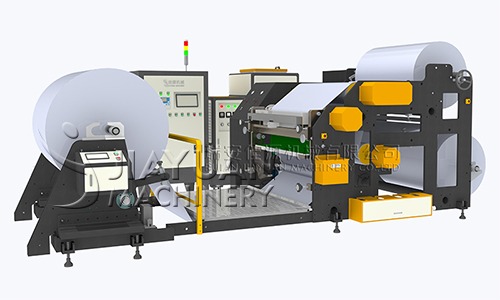
I. Daily Maintenance:
Conduct pre-startup, running, and post-shutdown checks (as previously detailed).
Thoroughly clean adhesive residue and dust generated during the day (especially around the coating head, drive rollers, and adhesive tank). Keep equipment clean.
Inspect and clean the adhesive tank inlet filter screen (if equipped).
Check the oil level in the oil cup of the pneumatic FRL unit (Filter, Regulator, Lubricator); replenish lubricating oil (e.g., ISOVG32 pneumatic oil) as needed. Drain accumulated water from the filter.
Inspect all fasteners (screws, nuts) for looseness.
Check the tension of drive belts/chains.
Complete the daily inspection checklist.
II. Weekly Maintenance:
Perform all Daily Maintenance items.
Clean the equipment more thoroughly, particularly hard-to-reach areas.
Inspect and clean the coating head components (e.g., doctor blade, nozzle, roller surfaces) to ensure no adhesive buildup or damage.
Check if the gear pump is running smoothly and listen for abnormal noises.
Inspect the appearance of heating elements (heating tubes/bands) for damage or burnout (must be performed after power-off and cooling).
Check that temperature sensors are securely positioned and have good contact.
Inspect electrical terminal connections for looseness or signs of overheating.
Lubricate drive chains, bearings, and other points requiring lubrication (use specified grease per equipment manual requirements).
III. Monthly/Quarterly Maintenance:
Perform all Weekly Maintenance items.
Key Focus: Filter Screen Cleaning/Replacement:
Dismantle and thoroughly clean (or replace) the main filter element/screen installed at the adhesive pump outlet or coating head inlet. This is critical for preventing blockages and ensuring adhesive purity! Cleaning/replacement frequency depends on adhesive cleanliness and usage volume.
Inspect the wear condition of the gear pump (monitor output pressure stability and listen for abnormal noises). Contact the manufacturer for inspection or replacement of worn parts (gears, bushings) if necessary.
Check the operation of pneumatic components (cylinders, solenoid valves) for normal function and air leaks.
Calibrate the temperature controller (compare with a standard thermometer to ensure accurate display).
Conduct a comprehensive check of electrical system insulation and grounding integrity.
Inspect the wear condition of moving parts (e.g., guide rails, sliding blocks, bearings).
IV. Annual Maintenance / Major Overhaul:
Perform all Monthly Maintenance items.
Contact the equipment supplier or qualified professional personnel for a comprehensive overhaul, including:
Deep cleaning of the entire adhesive path system.
Comprehensive inspection, testing, and potential replacement of aging or degraded heating elements, temperature sensors, and temperature control modules.
Comprehensive inspection, lubrication, or replacement of drive system components (motors, reducers, bearings, chains/belts).
Inspection, calibration, or replacement of pressure sensors and flow meters (if equipped).
Inspection of the control system (PLC, HMI) program, wiring, and backups.
Full performance testing and accuracy verification of the equipment.
V. Critical Maintenance Considerations
Filter Screens: This is the top maintenance priority! Clogged filters cause pressure increases, insufficient flow, uneven coating, and can even damage the gear pump. Implement a strict cleaning/replacement schedule based on adhesive purity and usage volume.
Cleaning: Keeping the equipment clean, especially the adhesive path system, is fundamental to preventing carbonization, blockages, and product contamination. Clean while hot!
Temperature: Precise and stable temperature control is core to ensuring adhesive performance and coating quality. Regularly calibrate the temperature control system. Avoid excessively high temperatures (accelerates adhesive aging, carbonization) or excessively low temperatures (poor flow, blockages).
Adhesive Management: Use qualified, dry, and clean adhesive. When switching between different adhesives, ensure the system is thoroughly cleaned.
Lubrication: Lubricate specified points at the defined intervals using the correct lubricant (type, grade) as required by the equipment manual. Both over-lubrication and under-lubrication can cause problems.
Record Keeping: Establish and strictly implement a maintenance record system (inspection checklists, maintenance logs, repair records). This is the foundation for tracking equipment status, preventing failures, and planning maintenance.
Professional Support: For complex faults or annual major overhauls, always contact the equipment manufacturer or a professional repair service provider. Use genuine spare parts or parts of equivalent quality.
Safety: All maintenance operations must be performed only when the equipment is completely stopped, powered off, depressurized, and cooled (especially when contacting high-temperature parts and electrical components). Strictly adhere to safety operating procedures.
The operation and maintenance of a Hot melt adhesive coating machine is a systematic process requiring responsibility, meticulousness, and expertise from both operators and maintenance personnel. Strictly following operating procedures and implementing a preventive maintenance plan—particularly focusing on cleanliness, filter screens, and precise temperature control—can significantly reduce unplanned downtime, extend equipment lifespan, ensure stable product quality, and improve production efficiency and economic benefits. Always prioritize safety during all operations and maintenance work.
 HOT LINE: 086-577-65159218
HOT LINE: 086-577-65159218












